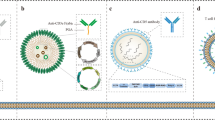Abstract
When parental Chinese hamster ovary (CHO) cell clones that are capable of producing thrombopoietin (TPO) were subjected to high methotrexate (MTX) concentrations, clonal variations in cell growth were apparent. In the clones that had no significant enhancement in specific TPO productivity (q Tpo) when a higher level of MTX was administered, their growth was not depressed significantly nor their cell size changed significantly. On the other hand, those clones that showed a significant enhancement inq Tpo at higher a MTX dosage, cell growth was depressed initially but recovered during successive sub-cultures. Furthermore, their cell size increased, which suggested that changes in cell size may be indicative of an enhancedq Tpo. When the enhancement of theq Tpo of 9 clones after a high MTX dosage was plotted against the extent of the increase of their size, there was a linear correlation (r 2=0.80,P<0.001, ANOVA), which suggested that an enhancement ofq Tpo after high MTX administration can be measured by the increase in their cell size. Taken together, our data demonstrate that the selection of amplified CHO cell clones with enhancedq Tpo can be done based upon their increased size and growth pattern. This facilitates the development of highly productive recombinant CHO cell lines.
Similar content being viewed by others
References
Reff, M. E. (1993) High-level production of recombinant immunoglobulins in mammalian cells.Curr. Opin. Biotechnol. 4: 573–576.
Trill, J. J., A. R. Shatzman, and S. Ganguly (1995) Production of monoclonal antibodies in COS and CHO cells.Curr. Opin. Biotechnol. 6: 553–560.
Kaufman, R. J., P. A. Sharp, and S. A. Latt (1983) Evolution of chromosomal regions containing transfected and amplified dihydrofolate reductase sequences.Mol. Cell. Biol. 3: 699–711.
Wurm, F. M. and C. J. Petropoulos (1994) Plasmid integration, amplification and cytogenetics in CHO cells: Questions and comments.Biologicals 22: 95–102.
Kim, N. S., S. J. Kim, and G. M. Lee (1998) Clonal variability within dihydrofolate reductase-mediated gene amplified Chinese hamster ovary cells: Stability in the absence of selective pressure.Biotechnol. Bioeng. 60: 679–688.
Kim, S. J., N. S. Kim, C. J. Ryu, H. J. Hong, and G. M. Lee (1998) Characterization of chimeric antibody producing CHO cells in the course of dihydrofolate reductasemediated gene amplification and their stability in the absence of selective pressure.Biotechnol. Bioeng. 58: 73–84.
Kim, N. S., T. H. Byun, and G. M. Lee (2001) Key determinants in the occurrence of clonal variation in humanized antibody expression of CHO cells during dihydrofolate reductase mediated gene amplification.Biotechnol. Prog. 17: 69–75.
Seewöster, T. and J. Lehmann (1997) Cell size distribution as a parameter for the predetermination of exponential growth during repeated batch cultivation of CHO cells.Biotechnol. Bioeng. 55: 793–797.
Lee, G. M., A. Varma, and B. O. Palsson (1991) Production of monoclonal antibody using free-suspended and immobilized hybridoma cells: Effect of serum.Biotechnol. Bioeng. 38: 821–830.
Assaraf, Y. G. and R. T. Schimke (1987) Identification of methotrexate transport deficiency in mammalian cells using fluoresceinated methotrexate and flow cytometry.Proc. Natl. Acad. Sci. USA 84: 7154–7158.
Flintoff, W. F. and K. Essani (1980) Methotrexateresistant Chinese hamster ovary cells contain a dihydrofolate reductase with an altered affinity for methotrexate.Biochemistry 19: 4321–4327.
Frame, K. K. and W. S. Hu (1990) Cell volume measurement as an estimation of mammalian cell biomass.Biotechnol. Bioeng. 36: 191–197.
Ramírez, O. T. and R. Mutharasan (1990) Cell cycle- and growth phase-dependent variations in size distribution, antibody productivity, and oxygen demand in hybridoma cultures.Biotechnol. Bioeng. 36: 839–848.
Author information
Authors and Affiliations
Corresponding author
Rights and permissions
About this article
Cite this article
Kim, T.K., Chung, J.Y., Sung, Y.H. et al. Relationship between cell size and specific thrombopoietin productivity in chinese hamster ovary cells during dihydrofolate reductase-mediated gene amplification. Biotechnol. Bioprocess Eng. 6, 332–336 (2001). https://doi.org/10.1007/BF02933001
Received:
Accepted:
Issue Date:
DOI: https://doi.org/10.1007/BF02933001




